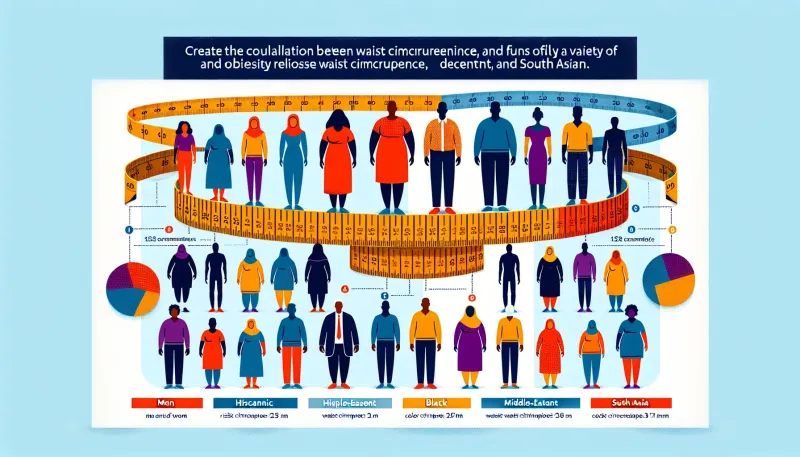Understanding the Link Between Waist Circumference and Obesity

Explore how waist circumference relates to obesity, its health implications, and how to manage it effectively. Get expert insights and practical tips to stay healthy.
Introduction
Obesity is a growing health concern worldwide, with numerous studies linking it to various health conditions such as heart disease, diabetes, and hypertension. Recent research has shown that waist circumference is a crucial indicator of obesity and related health risks. This article delves into the relationship between waist circumference and obesity, exploring why waist circumference is a critical measure, its implications, and ways to manage obesity effectively.
What is Waist Circumference?
Waist circumference is a measure of the distance around the smallest area below the rib cage and above the belly button. It is an important metric used by health professionals to assess abdominal fat. Abdominal fat, also known as visceral fat, is closely linked to several health risks, making waist circumference a reliable indicator of obesity and related health complications.
Why Waist Circumference Matters
Indicator of Visceral Fat
Waist circumference is a direct indicator of visceral fat, the fat stored around vital organs. Unlike subcutaneous fat, which is stored just beneath the skin, visceral fat is more metabolically active and significantly impacts health. High levels of visceral fat are associated with increased risks of metabolic syndrome, cardiovascular diseases, and type 2 diabetes.
Better Predictor of Health Risks than BMI
Body Mass Index (BMI) has long been used to classify individuals based on weight relative to height. However, BMI does not distinguish between muscle and fat mass, nor does it account for fat distribution. Waist circumference provides a more accurate assessment of health risks as it directly measures abdominal fat, offering a better predictor of obesity-related conditions.
Health Implications of Large Waist Circumference
Cardiovascular Diseases
Excessive visceral fat contributes to inflammation, insulin resistance, and lipid abnormalities, all of which increase the risk of cardiovascular diseases. Studies have shown that individuals with a larger waist circumference are more likely to develop conditions such as heart disease, stroke, and hypertension.
Diabetes
Visceral fat is closely linked to insulin resistance, a precursor to type 2 diabetes. Individuals with a higher waist circumference have higher levels of fasting insulin and glucose, making them more susceptible to developing diabetes.
Other Health Risks
A large waist circumference is also associated with other health risks, including respiratory problems, certain cancers, and a reduced quality of life. Maintaining a healthy waist circumference is crucial for overall well-being and longevity.
Measuring Waist Circumference
Measuring waist circumference is simple and requires a flexible measuring tape. Here are the steps:
- Stand upright and find the hip bone and the bottom of your ribs.
- Wrap the tape measure around your waist, making sure it is level with your belly button.
- Ensure the tape is snug but not compressing the skin.
- Record the measurement after exhaling normally.
For accuracy, it's recommended to take the measurement multiple times and use the average value.
Waist Circumference Guidelines
Health authorities have established guidelines for waist circumference to help identify at-risk individuals:
- For men: A waist circumference over 40 inches (102 cm) increases the risk of health problems.
- For women: A waist circumference over 35 inches (88 cm) is associated with higher health risks.
These thresholds are important markers for identifying individuals who may need to take steps to reduce their abdominal fat and improve their health outcomes.
Managing and Reducing Waist Circumference
Healthy Diet
A balanced and nutritious diet is paramount in managing waist circumference and overall health. Focus on consuming whole foods, including fruits, vegetables, lean proteins, and whole grains. Avoid excessive intake of sugars, refined carbohydrates, and unhealthy fats that contribute to visceral fat accumulation.
Regular Physical Activity
Engaging in regular physical activity helps burn calories and reduce visceral fat. Aim for at least 150 minutes of moderate-intensity exercise or 75 minutes of high-intensity exercise per week. Incorporate both aerobic activities (like walking, jogging, or cycling) and strength training exercises to maximize fat loss and muscle gain.
Lifestyle Changes
Adopting healthier lifestyle habits can significantly impact waist circumference. Reducing stress through techniques such as meditation or yoga, getting adequate sleep, and avoiding smoking or excessive alcohol consumption are essential strategies.
Medical Interventions
In some cases, medical interventions may be necessary. Consult a healthcare professional for personalized advice. Options may include medications, surgical procedures, or structured weight management programs.
Conclusion
Waist circumference is a crucial determinant of obesity and related health risks. Unlike BMI, it directly measures abdominal fat, providing a more accurate assessment of potential health issues. Understanding the importance of waist circumference can help individuals take proactive steps to reduce their risk of obesity-related conditions. By focusing on a healthy diet, regular physical activity, and lifestyle changes, it is possible to manage waist circumference effectively and improve overall health.
























